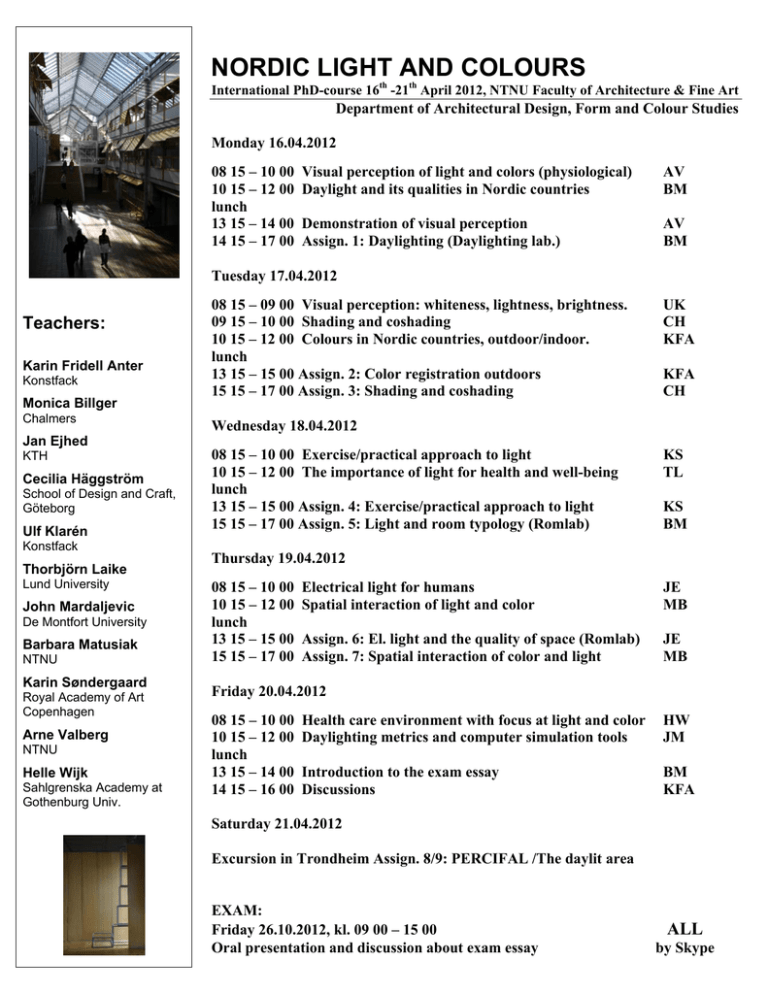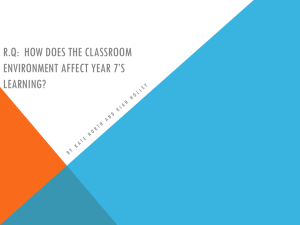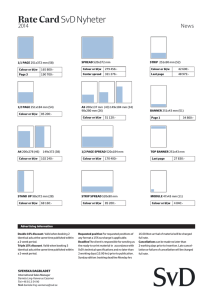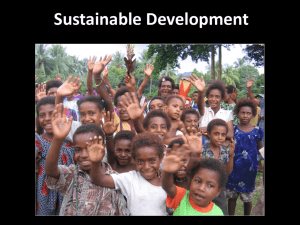Nordic light and colours course programme — NordForsk
advertisement

NORDIC LIGHT AND COLOURS International PhD-course 16th -21th April 2012, NTNU Faculty of Architecture & Fine Art Department of Architectural Design, Form and Colour Studies Monday 16.04.2012 08 15 – 10 00 10 15 – 12 00 lunch 13 15 – 14 00 14 15 – 17 00 Visual perception of light and colors (physiological) Daylight and its qualities in Nordic countries AV BM Demonstration of visual perception Assign. 1: Daylighting (Daylighting lab.) AV BM Tuesday 17.04.2012 Teachers: Karin Fridell Anter Konstfack Monica Billger Chalmers 08 15 – 09 00 Visual perception: whiteness, lightness, brightness. 09 15 – 10 00 Shading and coshading 10 15 – 12 00 Colours in Nordic countries, outdoor/indoor. lunch 13 15 – 15 00 Assign. 2: Color registration outdoors 15 15 – 17 00 Assign. 3: Shading and coshading UK CH KFA KFA CH Wednesday 18.04.2012 Jan Ejhed KTH Cecilia Häggström School of Design and Craft, Göteborg Ulf Klarén Konstfack Thorbjörn Laike Lund University John Mardaljevic De Montfort University Barbara Matusiak NTNU Karin Søndergaard Royal Academy of Art Copenhagen Arne Valberg NTNU Helle Wijk Sahlgrenska Academy at Gothenburg Univ. 08 15 – 10 00 Exercise/practical approach to light 10 15 – 12 00 The importance of light for health and well-being lunch 13 15 – 15 00 Assign. 4: Exercise/practical approach to light 15 15 – 17 00 Assign. 5: Light and room typology (Romlab) KS TL KS BM Thursday 19.04.2012 08 15 – 10 00 10 15 – 12 00 lunch 13 15 – 15 00 15 15 – 17 00 Electrical light for humans Spatial interaction of light and color JE MB Assign. 6: El. light and the quality of space (Romlab) Assign. 7: Spatial interaction of color and light JE MB Friday 20.04.2012 08 15 – 10 00 10 15 – 12 00 lunch 13 15 – 14 00 14 15 – 16 00 Health care environment with focus at light and color Daylighting metrics and computer simulation tools HW JM Introduction to the exam essay Discussions BM KFA Saturday 21.04.2012 Excursion in Trondheim Assign. 8/9: PERCIFAL /The daylit area EXAM: Friday 26.10.2012, kl. 09 00 – 15 00 Oral presentation and discussion about exam essay ALL by Skype Participants 15 PhD students Credits 7,5 ECTS Application Send an e-mail requesting an application to: sarah.by@ntnu.no An application form will be sent to you to be completed and returned by the deadline. All application forms must be submitted electronically. Deadline 15.01.2012 Language English. Exam form Written essay exam Course background and description The experiences of colour and light are interdependent and cannot be analyzed separately. The colours of the surrounding room influence our experiences of light and the need for lighting. The intensity, quality and distribution of light are essential for the perception and experience of colour. The aesthetics of colour and light play an important role in the fields of art, design and communication. Colour and light in architectural spaces influence our experiences and feelings, our comfort and our physiological well-being. A deep understanding of the interaction between colour and light demands an interdisciplinary approach, including such fields as psychology, neurology and lighting technology, as well as an in-depth understanding of colour and light applications in architectural spaces. Research on colour and light in spatial context is being done at several Nordic universities with participation in several working groups and committees within the international colour association AIC and the international commission of illumination CIE. This research has achieved high international standing. On the level of established research, a Nordic collaboration was started in 2009 in order to enhance a creative interchange between researchers and industrial developers with different approaches. Researchers from Sweden, Norway and Finland participate in the ongoing interdisciplinary research project SYN-TES: Colour and Light Synthesis: Towards a Coherent Field of Knowledge, based at Konstfack (2010-2011). (www.konstfack.se/SYN-TES). In order to keep up with and develop competence it is essential that research students working with different aspects of colour and light are introduced to and educated in the multidisciplinary complexity of their field. It is also important that research students working with neighboring issues, e.g. within the fields of architecture, psychology or health care, get the opportunity to understand how colour and light affect their field of work. Additionally, the course gives an opportunity to train young researchers in different methodological techniques. Expenses Travel and accommodation expenses, if moderate, will be covered for students from Nordic countries from the NordForsk foundation. Participation priority If the number of applicants exceeds 15, the PhD students for whom the topic of light and colour is most relevant in their research activity and who pass the introductory test will be prioritized. If the number is lower than 15, the opportunity for participation will be given to young researchers, i.e. MS/MA working with light or colour research projects. Project leaders: Barbara Matusiak: barbara.matusiak@ntnu.no Karin Fridell Anter: karinfa@explicator.se The course will gather students from different countries and disciplines so that they can work together across national, professional and disciplinary boundaries. This will help them form their own networks which, according to our experience, will facilitate their doctoral education and give a good start for their further collaboration in research and education. Lectures will be given by top scientists from Sweden, Norway, Denmark and the UK. The unique Daylight- and Room-laboratories of NTNU will be used for experiments and exercises. Academic and professional fields to be discussed in the course include: Physics/Biophysics (Arne Valberg), Perception Psychology (Ulf Klarén), Environmental Psychology (Thorbjörn Leike), Health and Care Sciences (Helle Wijk), Performative Art (Karin Søndergaard), Interior Architecture (Monica Billger), Colour Studies in Architecture (Karin Fridell Anter), Lighting Design (Jan Ejhed), Daylighting Design (Barbara Matusiak), Computer Visualization and Simulation (John Mardaljevic). To ensure a common knowledge base to start from, there will be an introductory syllabus by the course leaders. Candidates must pass an introductory test one month before the course start. The syllabus will include basic knowledge of light and lighting principles/terminology and understanding of the Natural Colour System (NCS). The Research Training Course Nordic Light and Colours is financed by NordForsk, an organization under the Nordic Council of Ministers that provides funding for Nordic research cooperation as well as advice and input on Nordic research policy. The course is open to PhD students from Universities in Nordic (*) and Baltic (**) countries. It welcomes students belonging to all disciplines, as long as colour and/or light issues are important in their thesis work. (*) Nordic is defined here as Denmark, Finland, Iceland, Norway, Sweden and the autonomous areas, Faroe Islands, Greenland, and Åland Islands. (**) Baltic is defined here as Estonia, Lithuania, and Latvia.







